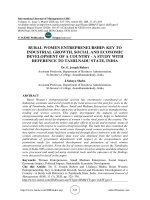Economic growth and economic development 77
Bạn đang xem bản rút gọn của tài liệu. Xem và tải ngay bản đầy đủ của tài liệu tại đây (166.38 KB, 1 trang )
Introduction to Modern Economic Growth
Theorem 2.3. Consider the following nonlinear autonomous system
(2.25)
x (t + 1) = G [x (t)]
with initial value x (0), where G :Rn → Rn . Let x∗ be a steady state of this system,
i.e., G (x∗ ) = x∗ , and suppose that G is continuously differentiable at x∗ . Define
A ≡∇G (x∗ ) ,
and suppose that all of the eigenvalues of A are strictly inside the unit circle. Then
the steady state of the difference equation (2.25) x∗ is locally asymptotically stable,
in the sense that there exists an open neighborhood of x∗ , B (x∗ ) ⊂ Rn such that
starting from any x (0) ∈ B (x∗ ), we have x (t) → x∗ .
Proof. See Luenberger (1979, Chapter 9).
Ô
An immediate corollary of Theorem 2.3 the following useful result:
Corollary 2.1. Let x (t) , a, b ∈ R, then the unique steady state of the linear
difference equation x (t + 1) = ax (t) + b is globally asymptotically stable (in the
sense that x (t) → x∗ = b/ (1 − a)) if |a| < 1.
Let g : R → R be a continuous function, differentiable at the steady state x∗ ,
defined by g (x∗ ) = x∗ . Then, the steady state of the nonlinear difference equation
x (t + 1) = g (x (t)), x∗ , is locally asymptotically stable if |g0 (x∗ )| < 1. Moreover, if
|g 0 (x)| < 1 for all x ∈ R, then x∗ is globally asymptotically stable.
Proof. The first part follows immediately from Theorem 2.2. The local stability
of g in the second part follows from Theorem 2.3. Global stability follows since
|x(t + 1) − x∗ | = |g(x(t)) − g(x∗ )|
¯Z
¯
¯ x(t)
¯
¯
¯
= ¯
g0 (x)dx¯
¯ x∗
¯
< |x(t) − x∗ |,
where the last inequality follows from the hypothesis that |g 0 (x)| < 1 for all x
Ô
R.
We can now apply Corollary 2.1 to the equilibrium difference equation of the
Solow model, (2.16):
63









